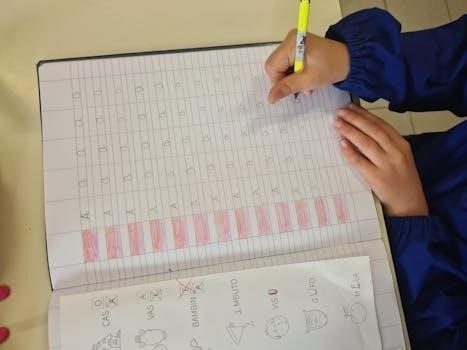Factoring Trinomials When a is Not 1⁚ An Overview
Factoring trinomials where the leading coefficient ‘a’ isn’t 1 presents a unique challenge. This involves more intricate steps than when ‘a’ equals 1. Mastering techniques like the ‘ac’ method becomes essential. Worksheets provide varied practice. These resources include step-by-step solutions and examples which are designed to enhance understanding.
Understanding Trinomials Where a ≠ 1
Trinomials, polynomial expressions with three terms, take on a new complexity when the coefficient of the (x^2) term, denoted as ‘a’, is not equal to 1. Unlike simple trinomials where factoring often involves finding two numbers that add up to the middle term’s coefficient and multiply to the constant term, these trinomials require a more nuanced approach. Recognizing the structure (ax^2 + bx + c) is the first step. The ‘a’ value impacts the factoring process significantly.
Methods like the ‘ac’ method become invaluable. This method helps break down the middle term, ‘bx’, into two terms that allow for factoring by grouping. Understanding this method is essential for efficiently factoring these types of trinomials. Worksheets designed for practice often include a variety of examples with different values for ‘a’, ‘b’, and ‘c’. This is crucial for mastering the concept.
These worksheets also offer step-by-step solutions, helping students understand each step in the process. Practice is key. By working through various examples, students can develop an intuition for identifying factorable trinomials. They can also learn to apply the appropriate techniques to find the correct factors, which leads to greater confidence and proficiency in algebra.
Methods for Factoring⁚ The ‘ac’ Method (Factoring by Grouping)
The ‘ac’ method, also known as factoring by grouping, provides a structured approach for factoring trinomials where the leading coefficient (a) is not equal to one. This method transforms a seemingly complex problem into a series of simpler steps. First, identify the coefficients ‘a’, ‘b’, and ‘c’ in the trinomial (ax^2 + bx + c). Then, calculate the product of ‘a’ and ‘c’. The next crucial step involves finding two numbers that multiply to ‘ac’ and add up to ‘b’.
Once these two numbers, let’s call them ‘p’ and ‘q’, are found, rewrite the middle term ‘bx’ as the sum of ‘px’ and ‘qx’. This transforms the trinomial into a four-term polynomial⁚ ax^2 + px + qx + c. Now, factor by grouping. Group the first two terms and the last two terms together. Factor out the greatest common factor (GCF) from each group. The resulting expression should have a common binomial factor.
Factor out this common binomial factor, leaving you with the factored form of the trinomial. Worksheets that focus on the ‘ac’ method often provide numerous examples, guiding students through each step. These examples are valuable for building a solid understanding of the technique. Practice problems and detailed solutions found in worksheets ensure mastery of this essential factoring skill.
Worksheet Examples⁚ Factoring with Leading Coefficients Greater Than 1
Worksheets offer a diverse array of examples that tackle factoring trinomials with leading coefficients greater than 1. These examples are essential for grasping different scenarios and applying appropriate techniques. Consider the trinomial 2x^2 + 5x + 2. A worksheet might guide you through factoring this by first identifying a=2, b=5, and c=2. Using the ‘ac’ method, ac = 4. You then need to find two numbers that multiply to 4 and add up to 5. These numbers are 4 and 1.
Rewrite the middle term as 4x + x, transforming the trinomial into 2x^2 + 4x + x + 2. Group the terms⁚ (2x^2 + 4x) + (x + 2). Factor out the GCF from each group⁚ 2x(x + 2) + 1(x + 2). Now, factor out the common binomial factor (x + 2), resulting in (2x + 1)(x + 2). Thus, the factored form of 2x^2 + 5x + 2 is (2x + 1)(x + 2).
Another example might be 3p^2 ⎼ 2p ⎼ 5. Worksheets often include more complex examples, such as those requiring factoring out a GCF before applying other methods. They also cover cases where the trinomial might not be factorable, emphasizing the importance of recognizing prime trinomials. Through varied exercises and step-by-step solutions, worksheets provide invaluable practice in mastering factoring trinomials with leading coefficients greater than 1, reinforcing key concepts and building problem-solving skills.
Step-by-Step Solutions⁚ Decomposing the Middle Term
Decomposing the middle term is a pivotal step when factoring trinomials where ‘a’ is not 1. This method, often part of the ‘ac’ method, transforms the trinomial into a four-term polynomial, facilitating factoring by grouping. Consider the trinomial 6x^2 + 11x + 4. First, identify ‘a’ as 6, ‘b’ as 11, and ‘c’ as 4. Calculate ac, which is 6 * 4 = 24. Next, find two numbers that multiply to 24 and add up to 11. These numbers are 8 and 3.
Rewrite the middle term (11x) using these numbers⁚ 6x^2 + 8x + 3x + 4. Now, group the terms⁚ (6x^2 + 8x) + (3x + 4). Factor out the greatest common factor (GCF) from each group. From the first group, the GCF is 2x, so we get 2x(3x + 4). From the second group, the GCF is 1, so we get 1(3x + 4). Notice that both groups now have a common binomial factor, (3x + 4).
Factor out this common binomial⁚ (3x + 4)(2x + 1). The trinomial 6x^2 + 11x + 4 is now factored into (3x + 4)(2x + 1). This step-by-step approach clarifies how to systematically decompose the middle term, making factoring more manageable. It emphasizes the importance of accurate identification of factors and careful grouping to achieve the correct factored form.

Common Mistakes to Avoid When Factoring
Factoring trinomials, especially when ‘a’ is not 1, can be tricky. One common mistake is incorrectly identifying the factors of ‘ac’ that sum to ‘b’. Always double-check that the chosen factors satisfy both conditions. Another frequent error is mishandling signs. Pay close attention to whether the factors should be positive or negative to ensure they add up to the correct ‘b’ value.
Forgetting to factor out the greatest common factor (GCF) at the beginning is also a pitfall. Failing to do so can complicate the factoring process significantly. Always look for a GCF first to simplify the trinomial. Incorrectly applying the distributive property during factoring by grouping is another common error. Make sure to distribute correctly when checking your factored expression against the original trinomial.
Another mistake is stopping prematurely. Ensure that the factored expression cannot be factored further. Sometimes, one of the binomial factors might itself be factorable. Finally, not checking your answer is a significant oversight. Always multiply the factored binomials to verify that they result in the original trinomial. Avoiding these mistakes will enhance accuracy and confidence in factoring.
Factoring Trinomials with GCF Before Applying Other Methods
Before diving into complex factoring techniques for trinomials where ‘a’ is not 1, identifying and factoring out the greatest common factor (GCF) is crucial. This initial step simplifies the trinomial, making subsequent factoring much easier. Overlooking the GCF is a common mistake that leads to more complicated calculations and potential errors.
Finding the GCF involves identifying the largest factor common to all terms of the trinomial. Once found, divide each term by the GCF and rewrite the trinomial as the GCF multiplied by the resulting expression. This process reduces the coefficients and constants, often turning a difficult problem into a manageable one. For example, consider the trinomial 6x² + 12x + 6.
The GCF is 6. Factoring out the 6 results in 6(x² + 2x + 1). Now, the trinomial inside the parentheses is much simpler to factor. In this case, it factors to (x + 1)(x + 1). The complete factored form is 6(x + 1)(x + 1) or 6(x + 1)². Always prioritize finding and factoring out the GCF before employing other factoring methods to streamline the process and minimize errors.

Using the Quadratic Formula as a Last Resort
When faced with a trinomial that resists all standard factoring methods, such as the ‘ac’ method or recognizing special patterns, the quadratic formula provides a reliable alternative. This formula, x = [-b ± √(b² ⎼ 4ac)] / (2a), yields the solutions (roots) of any quadratic equation in the form ax² + bx + c = 0. While factoring is generally quicker, the quadratic formula guarantees a solution, even for non-factorable trinomials.
To apply the quadratic formula, correctly identify the coefficients a, b, and c from the trinomial. Substitute these values into the formula and simplify. The discriminant, b² ⸺ 4ac, reveals the nature of the solutions⁚ if positive, there are two real solutions; if zero, there is one real solution; and if negative, there are two complex solutions.
Once the solutions, x1 and x2, are obtained, they can be used to construct the factored form of the trinomial as a(x ⸺ x1)(x ⎼ x2). Remember, the quadratic formula should be a last resort, employed when factoring proves too difficult or impossible. It ensures that you can always find the solutions to a quadratic equation, regardless of its factorability.

Applications of Factoring Trinomials in Algebra
Factoring trinomials, particularly those where ‘a’ is not 1, is a fundamental skill with wide-ranging applications in algebra and beyond. It’s not just an abstract exercise; it’s a tool that unlocks solutions to real-world problems. One key application lies in solving quadratic equations. By factoring a quadratic equation into the form (ax + b)(cx + d) = 0, we can easily find the values of x that make the equation true. These solutions represent the points where the parabola intersects the x-axis.
Factoring also simplifies complex algebraic expressions. It allows us to rewrite expressions in a more manageable form, making them easier to work with in further calculations. This is particularly useful in calculus and other advanced math courses. Simplifying rational expressions is another area where factoring shines. By factoring both the numerator and denominator, we can identify common factors that can be cancelled out, leading to a simpler expression.
Moreover, factoring is crucial in graphing quadratic functions. The factored form reveals the x-intercepts, which are essential for sketching the parabola. In practical scenarios, factoring helps solve problems involving area, projectile motion, and optimization. Therefore, mastering factoring trinomials equips you with a powerful tool for tackling various algebraic challenges.

Practice Problems and Worksheet Resources (PDF Downloads)
To truly master factoring trinomials where ‘a’ is not equal to 1, consistent practice is essential. Thankfully, a wealth of resources is available online to help you hone your skills. Worksheets offering a variety of problems, ranging from simple to complex, are invaluable tools. These worksheets often include answer keys, allowing you to check your work and identify areas where you may need additional focus.
Many websites provide free, printable PDF worksheets specifically designed for factoring trinomials with leading coefficients other than 1. These resources often categorize problems by difficulty level, enabling you to gradually build your proficiency. Look for worksheets that incorporate different factoring methods, such as the ‘ac’ method or factoring by grouping, to ensure a well-rounded understanding.
In addition to standard worksheets, consider exploring resources that offer unique approaches to practice, such as coloring sheets or mini-quizzes. These can add an element of fun and engagement to the learning process. Remember, consistent practice is key to developing fluency in factoring trinomials. Download various PDF worksheets and dedicate time to working through the problems. This hands-on approach will solidify your understanding and boost your confidence in tackling these types of algebraic challenges.
